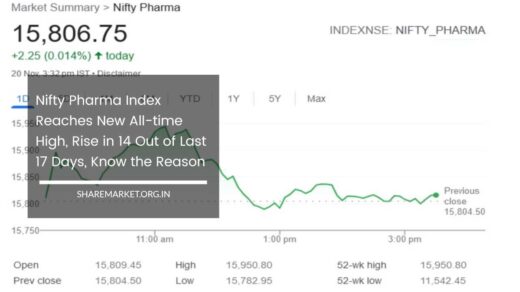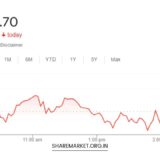Market Near All-Time Highs, Is It Right Time to Sell Equity Mutual Funds?

Equity Mutual Funds
No Problem for Investors Who Want to Invest Money for Long Term
The Nifty 50 index is very close to its all-time high. In such a situation, it is natural for investors to panic. On four occasions since October 2021, the Nifty 50 index has fallen 10-15 percent after crossing the 18,000 mark.
And now the market is close to 19,000, investors are being watched cautiously. However, investment advisors are emphasizing asset allocation rather than focusing on short-term returns.”
Investors who have a long-term investment horizon need not worry about the current situation in the stock market.
While the Nifty 50 index is approaching its all-time high, it is common for markets to experience fluctuations and temporary corrections.
In the past, there have been instances where the index has fallen by 10-15 percent after surpassing the 18,000 mark.
Given that the market is now close to 19,000, investors may understandably be cautious. However, it’s important to note that short-term market movements can be unpredictable, and trying to time the market can be challenging. Investment advisors are suggesting a different approach to mitigate risks and maximize returns – asset allocation.
Asset allocation involves diversifying investments across different asset classes, such as stocks, bonds, real estate, and commodities, based on an investor’s risk tolerance, financial goals, and time horizon. By spreading investments across various assets, investors can reduce their exposure to the volatility of a single asset class or market.
The emphasis on asset allocation highlights the importance of maintaining a well-balanced portfolio rather than focusing solely on short-term returns.
By having a long-term perspective and a diversified portfolio, investors can potentially ride out short-term market fluctuations and benefit from the overall growth of their investments over time.
What is the Gap Between This High and the Last High?
The gap between the current high and the last high of the Nifty 50 index can be determined by comparing the respective levels and assessing the changes in valuation ratios.
On December 1, 2022, the Nifty 50 index reached a high of 18,887, with a Price to Earnings (P/E) ratio of 22.61. As of June 16, 2023, the index was at 18,826, with a P/E ratio of 21.92.
This indicates that the index has experienced a slight decrease in both level and valuation ratio since the previous high.
To provide further context, let’s consider the situation four years ago, specifically on June 17, 2019, when the Nifty 50 index was trading at a P/E ratio of 28.87. Comparing the current valuation with that of 2019, it is evident that the valuation has decreased over time.
For many investors, the concern arises when stock prices are perceived to be at high levels. However, it is important to note that the current valuation of the Nifty 50 index is not necessarily considered very expensive, though it may not be particularly attractive either.
Nirav Karkera, head of research at the mutual fund distribution platform Fisdom, suggests that various factors indicate positive signs for the economy.
These factors include a rising manufacturing Purchasing Managers’ Index (PMI), continued government capital expenditure, and increased demand for loans from banks with strong balance sheets. These indicators suggest that the economy is approaching its previous highs.
Furthermore, the relatively low valuation of the index at this time can be seen as a positive sign. It may present opportunities for investors to consider investing, as the valuation is comparatively lower than it has been in the past.
Despite the increase in interest rates compared to the previous year, there haven’t been significant reductions in economic growth expectations. Given this situation, there is no immediate cause for concern for investors who have a long-term investment horizon.
Arun Kumar of FundsIndia.com suggests that when market valuations have risen considerably, the earnings cycle is in its final phase, and yet the market displays unusual enthusiasm, it could be a sign of a market bubble.
In such cases, caution is advised when it comes to equity investments. However, it is important to note that there is no indication of a major bubble in India’s markets at the present time.
The markets are not considered to be excessively expensive, and they are still in the early stages of the earnings cycle. Additionally, there is no prevailing sense of euphoria among investors.
This assessment suggests that the current market conditions in India do not exhibit the characteristics typically associated with a market bubble.
While caution is always advisable, especially in evaluating equity investments, the absence of excessive valuations and the early stage of the earnings cycle provide a relatively favorable investment environment.
Will the Market Still Rise More?
Predicting the future direction of the market is inherently challenging and subject to various factors. In the case of India’s market, several considerations come into play.
India has been relatively less affected by the COVID-19 pandemic compared to other countries. However, it is important not to overlook the potential risks. One significant factor that could impact market sentiment is a potential increase in interest rates by the US Federal Reserve.
Such a move could have repercussions globally, including in India, and might lead to a negative impact on market sentiment.
Additionally, if other central banks, including the Reserve Bank of India (RBI), decide to hike interest rates in response to changing economic conditions, it could exert pressure on the market. The actions of central banks have the potential to influence investor behavior and market dynamics.
Foreign Institutional Investors (FIIs) continue to play a significant role in the Indian market. In May 2023, FIIs purchased Rs. 27,856 crore worth of Indian equities, marking three consecutive months of buying.
Whether this trend of FII inflows continues will be crucial in determining the future trajectory of the market.
If FIIs continue to invest in Indian equities, along with steady domestic investment, it could pave the way for the market to reach new highs. The inflow of foreign funds can provide liquidity and contribute to positive market sentiment.
However, if FIIs decide to withdraw a substantial amount of money from India, it could potentially lead to increased volatility in the market.
The behavior of FIIs is influenced by various factors, including global economic conditions, market outlook, and their own investment strategies. Any significant shifts in FII investment patterns can impact market movements.
Mumbai-based mutual fund distributor Vinayak Kulkarni advises against selling equity mutual funds simply because the markets are near all-time highs. Instead, he suggests that investors should only consider booking profits if they have a short-term financial goal in mind.
This approach acknowledges the potential for market volatility but emphasizes the importance of aligning investment decisions with specific financial objectives.
Nirav Karkera believes that the risk-reward balance in large-cap stocks is more favorable compared to small and mid-cap stocks.
As a result, he recommends allocating a larger portion of investments to large-cap or flexi-cap funds at this time. For investors interested in small and mid-cap funds, he suggests considering index funds or actively managed funds.
Considering the slightly expensive market valuations, Arun Kumar suggests a systematic approach to investing. He recommends utilizing a Systematic Transfer Plan (STP) to invest 30% of the total allocation over the course of the next six months.
This approach allows for spreading investments over time, potentially mitigating the impact of short-term market fluctuations.
Vinayak Kulkarni also advocates for portfolio diversification by allocating at least 5 to 10 percent of the portfolio to gold. Investing in gold exchange-traded funds (ETFs) in regular installments, along with equity funds, is his recommended strategy.
Kulkarni reassures investors that volatility should not be a cause for concern, and he advises continuing Systematic Investment Plans (SIPs) in equity mutual funds.
Investing through SIPs can help investors build a substantial corpus over time by consistently investing fixed amounts at regular intervals.
These recommendations highlight the importance of a balanced and diversified investment strategy tailored to individual financial goals.
It is crucial for investors to evaluate their risk tolerance, consider professional advice, and make investment decisions based on their specific circumstances and long-term objectives.
Disclaimer: The opinions and investment advice provided on sharemarket.org.in are the personal viewpoints and recommendations of investment experts. We strongly advise users to seek the guidance of a certified expert before making any investment decisions.

















